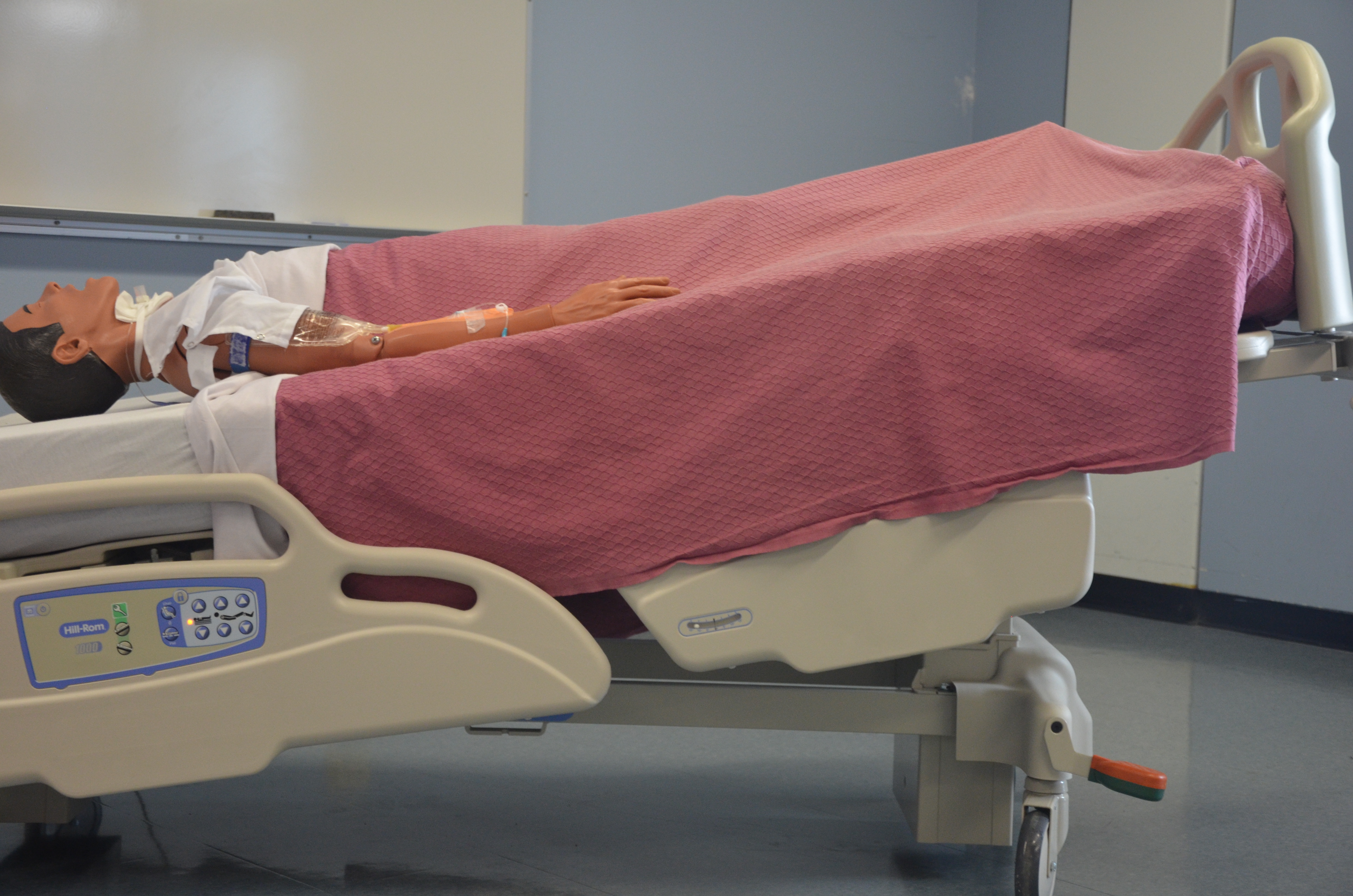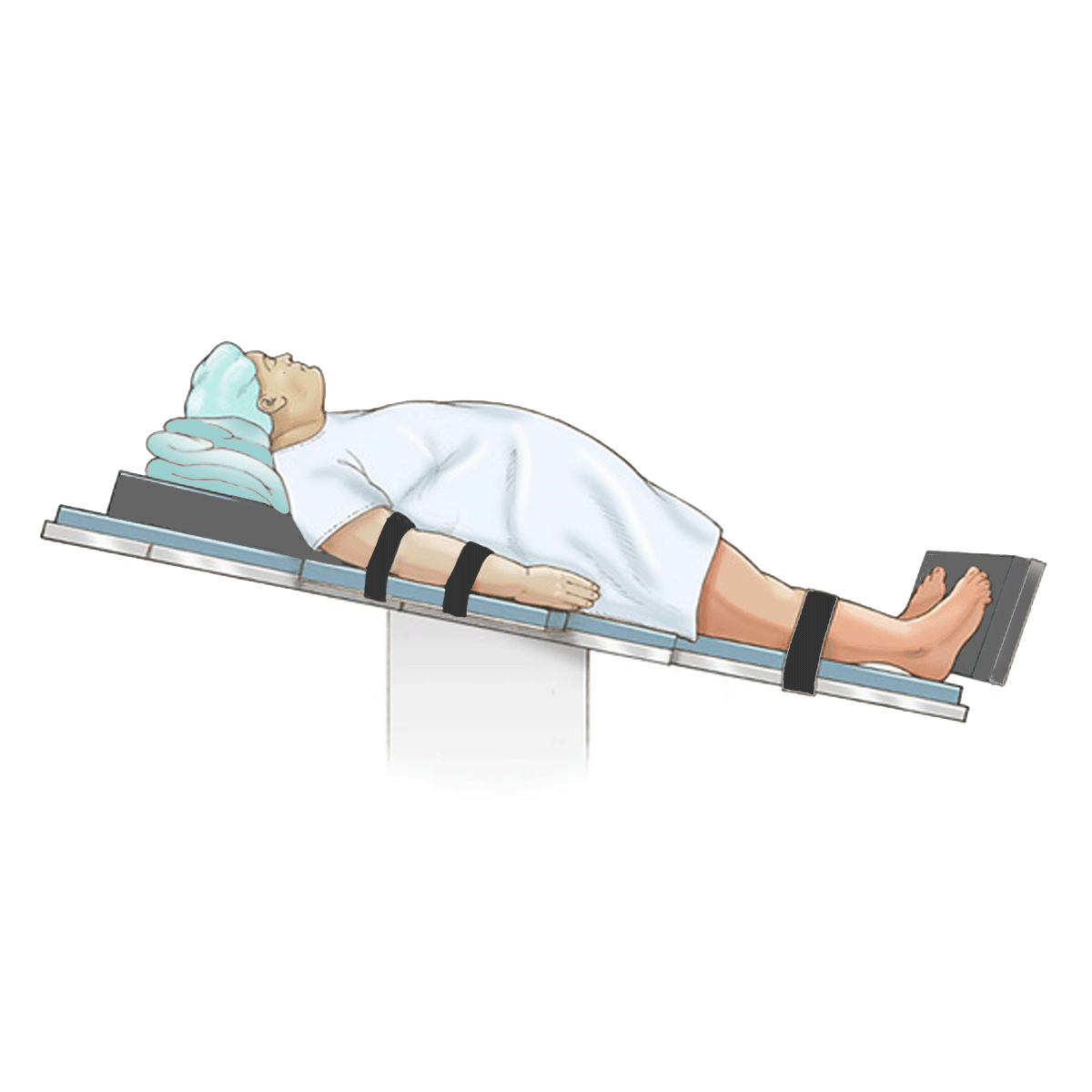Trendelenburg position on:
[Wikipedia]
[Google]
[Amazon]

 In the Trendelenburg position, the body is lain supine, or flat on the back on a 15–30 degree incline with the feet elevated above the head. The reverse Trendelenburg position, similarly, places the body supine on an incline but with the head now being elevated.
The Trendelenburg position is used in surgery, especially of the abdomen and genitourinary system. It allows better access to the pelvic organs as gravity pulls the intra-abdominal organs away from the pelvis. Evidence does not support its use in
In the Trendelenburg position, the body is lain supine, or flat on the back on a 15–30 degree incline with the feet elevated above the head. The reverse Trendelenburg position, similarly, places the body supine on an incline but with the head now being elevated.
The Trendelenburg position is used in surgery, especially of the abdomen and genitourinary system. It allows better access to the pelvic organs as gravity pulls the intra-abdominal organs away from the pelvis. Evidence does not support its use in
 *The Trendelenburg position can be used to treat a venous air embolism by placing the right ventricular outflow tract inferior to the right ventricular cavity, causing the air to migrate superiorly into a position within the right ventricle from which air is less likely to embolise.
Most recently, the reverse Trendelenburg position has been used in minimally invasive glaucoma surgery, also known as MIGS. This position is commonly used for a superior sitting surgeon that uses a combination of downward patient tilt, of approximately 30 to 35 degrees, microscope tilt towards themselves at the same angle and an intraoperative goniolens or prisms that allows them to visualise the inferior trabecular meshwork. Some joysticking of the globe may be required with an appropriate goniolens to bring the meshwork into view.
* The Trendelenburg position along with the
*The Trendelenburg position can be used to treat a venous air embolism by placing the right ventricular outflow tract inferior to the right ventricular cavity, causing the air to migrate superiorly into a position within the right ventricle from which air is less likely to embolise.
Most recently, the reverse Trendelenburg position has been used in minimally invasive glaucoma surgery, also known as MIGS. This position is commonly used for a superior sitting surgeon that uses a combination of downward patient tilt, of approximately 30 to 35 degrees, microscope tilt towards themselves at the same angle and an intraoperative goniolens or prisms that allows them to visualise the inferior trabecular meshwork. Some joysticking of the globe may be required with an appropriate goniolens to bring the meshwork into view.
* The Trendelenburg position along with the
 * People with
* People with
Illustration of position in comparison to other positions
Human Kinetics' Victim Positioning
According to The Canadian Journal of Anesthesia
{{DEFAULTSORT:Trendelenburg Position Surgery Gynaecology Human positions

 In the Trendelenburg position, the body is lain supine, or flat on the back on a 15–30 degree incline with the feet elevated above the head. The reverse Trendelenburg position, similarly, places the body supine on an incline but with the head now being elevated.
The Trendelenburg position is used in surgery, especially of the abdomen and genitourinary system. It allows better access to the pelvic organs as gravity pulls the intra-abdominal organs away from the pelvis. Evidence does not support its use in
In the Trendelenburg position, the body is lain supine, or flat on the back on a 15–30 degree incline with the feet elevated above the head. The reverse Trendelenburg position, similarly, places the body supine on an incline but with the head now being elevated.
The Trendelenburg position is used in surgery, especially of the abdomen and genitourinary system. It allows better access to the pelvic organs as gravity pulls the intra-abdominal organs away from the pelvis. Evidence does not support its use in hypovolaemic shock
Hypovolemia, also known as volume depletion or volume contraction, is a state of abnormally low extracellular fluid in the body. This may be due to either a loss of both salt and water or a decrease in blood volume. Hypovolemia refers to the loss ...
, with concerns for negative effects on the lungs and brain.
The position was named for the German surgeon Friedrich Trendelenburg (1844–1924).
Current uses
 *The Trendelenburg position can be used to treat a venous air embolism by placing the right ventricular outflow tract inferior to the right ventricular cavity, causing the air to migrate superiorly into a position within the right ventricle from which air is less likely to embolise.
Most recently, the reverse Trendelenburg position has been used in minimally invasive glaucoma surgery, also known as MIGS. This position is commonly used for a superior sitting surgeon that uses a combination of downward patient tilt, of approximately 30 to 35 degrees, microscope tilt towards themselves at the same angle and an intraoperative goniolens or prisms that allows them to visualise the inferior trabecular meshwork. Some joysticking of the globe may be required with an appropriate goniolens to bring the meshwork into view.
* The Trendelenburg position along with the
*The Trendelenburg position can be used to treat a venous air embolism by placing the right ventricular outflow tract inferior to the right ventricular cavity, causing the air to migrate superiorly into a position within the right ventricle from which air is less likely to embolise.
Most recently, the reverse Trendelenburg position has been used in minimally invasive glaucoma surgery, also known as MIGS. This position is commonly used for a superior sitting surgeon that uses a combination of downward patient tilt, of approximately 30 to 35 degrees, microscope tilt towards themselves at the same angle and an intraoperative goniolens or prisms that allows them to visualise the inferior trabecular meshwork. Some joysticking of the globe may be required with an appropriate goniolens to bring the meshwork into view.
* The Trendelenburg position along with the Valsalva maneuver
The Valsalva maneuver is performed by a forceful attempt of exhalation against a closed airway, usually done by closing one's mouth and pinching one's nose shut while expelling air out as if blowing up a balloon. Variations of the maneuver can ...
, termed as modified-Valsalva maneuver, can also be used for the cardioversion
Cardioversion is a medical procedure by which an abnormally fast heart rate ( tachycardia) or other cardiac arrhythmia is converted to a normal rhythm using electricity or drugs. Synchronized electrical cardioversion uses a therapeutic dose ...
of supraventricular tachycardia.
* The Trendelenburg position is helpful in surgical reduction of an abdominal hernia.
* The Trendelenburg position is also used when placing a central venous catheter
A central venous catheter (CVC), also known as a central line(c-line), central venous line, or central venous access catheter, is a catheter placed into a large vein. It is a form of venous access. Placement of larger catheters in more centra ...
in the internal jugular or subclavian vein. The Trendelenburg position uses gravity to assist in the filling and distension of the upper central veins, as well as the external jugular vein. It plays no role in the placement of a femoral central venous catheter.
*The Trendelenburg position can also be used in respiratory patients to create better perfusion.
*The Trendelenburg position has occasionally been used to produce symptomatic relief from septum posticum cysts of the subarachnoid space in the spinal cord, but does not bring about any long-term benefits.
*The Trendelenburg position may be used for drainage images during endoscopic retrograde cholangiopancreatography
Endoscopic retrograde cholangiopancreatography (ERCP) is a technique that combines the use of endoscopy and fluoroscopy to diagnose and treat certain problems of the biliary or pancreatic ductal systems. It is primarily performed by highly skille ...
.
*The Trendelenburg position is reasonable in those with a cord prolapse
Umbilical cord prolapse is when the umbilical cord comes out of the uterus with or before the presenting part of the baby. The concern with cord prolapse is that pressure on the cord from the baby will compromise blood flow to the baby. It usuall ...
who are unable to achieve a knee-to-chest position. It is a temporary measure until a cesarean section
Caesarean section, also known as C-section or caesarean delivery, is the surgical procedure by which one or more babies are delivered through an incision in the mother's abdomen, often performed because vaginal delivery would put the baby or ...
can be performed.
Controversial uses
 * People with
* People with hypotension
Hypotension is low blood pressure. Blood pressure is the force of blood pushing against the walls of the arteries as the heart pumps out blood. Blood pressure is indicated by two numbers, the systolic blood pressure (the top number) and the dia ...
(low blood pressure) have historically been placed in the Trendelenburg position in hopes of increasing blood flow to the brain. A 2005 review found the "Literature on the position was scarce, lacked strength, and seemed to be guided by 'expert opinion.'" A 2008 meta-analysis found adverse consequences to the use of the Trendelenburg position and recommended it be avoided. However, the passive leg raising test is a useful clinical guide to fluid resuscitation and can be used for effective autotransfusion. The Trendelenburg position used to be the standard first aid position for shock
Shock may refer to:
Common uses Collective noun
*Shock, a historic commercial term for a group of 60, see English numerals#Special names
* Stook, or shock of grain, stacked sheaves
Healthcare
* Shock (circulatory), circulatory medical emergen ...
.
* The Trendelenburg position can also be used in the treatment of scuba divers with decompression sickness
Decompression sickness (abbreviated DCS; also called divers' disease, the bends, aerobullosis, and caisson disease) is a medical condition caused by dissolved gases emerging from solution as bubbles inside the body tissues during decompressio ...
or arterial gas embolism
An air embolism, also known as a gas embolism, is a blood vessel blockage caused by one or more bubbles of air or other gas in the circulatory system. Air can be introduced into the circulation during surgical procedures, lung over-expansion ...
. Many experienced divers still believe this position is appropriate, but current scuba first aid professionals no longer advocate elevating the feet higher than the head. The Trendelenburg position in this case increases regurgitation and airway problems, causes the brain to swell, increases breathing difficulty, and has not been proven to be of any value. "Supine is fine" is a good, general rule for victims of submersion injuries unless they have fluid in the airway or are breathing, in which case they should be positioned in the recovery position.
See also
*Fowler's position
In medicine, Fowler's position is a standard patient position in which the patient is seated in a semi-sitting position (45-60 degrees) and may have knees either bent or straight. Variations in the angle are denoted by high Fowler, indicating an u ...
* High Fowler's position
* Recovery position
* Semi-Fowler's position
* Trendelenburg gait
Trendelenburg gait, named after Friedrich Trendelenburg, is an abnormal gait. It is caused by weakness or ineffective action of the gluteus medius muscle and the gluteus minimus muscle.
Gandbhir and Rayi point out that the biomechanical action ...
* Trendelenburg's sign
Trendelenburg's sign is found in people with weak or paralyzed abductor muscles of the hip, namely gluteus medius and gluteus minimus. It is named after the German surgeon Friedrich Trendelenburg. It is often incorrectly referenced as the Tr ...
References
External links
Illustration of position in comparison to other positions
Human Kinetics' Victim Positioning
According to The Canadian Journal of Anesthesia
{{DEFAULTSORT:Trendelenburg Position Surgery Gynaecology Human positions